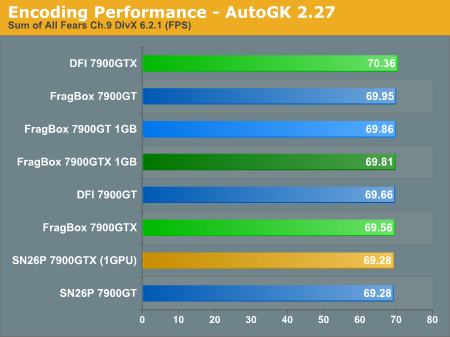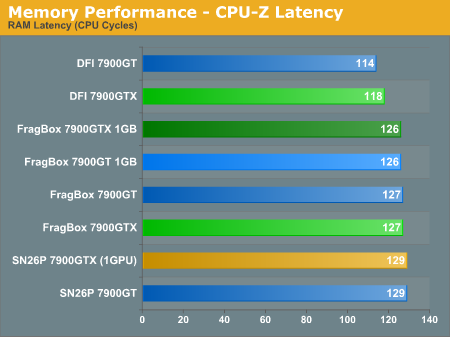Falcon Northwest FragBox SLI: Dare to Dream
by Jarred Walton on May 3, 2006 9:00 AM EST- Posted in
- Systems
Encoding Performance
For our encoding tests, we used AutoGK 2.27 with Xvid 1.2 and DivX 6.1.1. Note that we have upgraded to the latest versions of AutoGK as well as more recent versions of Xvid and DivX. DivX and Xvid should now show improved performance with multi-core configurations, and scores are not directly comparable with older AutoGK results that we've reported. We're still encoding the same content (chapter 9 from The Sum of All Fears), though, and if you're interested in seeing how the change to the new versions affected performance, we did include results using the earlier versions on the FragBox system. (The earlier results are shown in red.)


There are slight variations in encoding performance, but basically all of the system configurations are tied. Again, this is what we like to see, because it generally means that all of the computer configurations are pretty well optimized.
Memory Latency
CPU-Z includes a program called latency.exe that can be used to get a rough estimate of cache and memory latency. We used version 1.33 and converted the latency from CPU cycles into nanoseconds.

While there are noticeable differences in latency, even when using the same memory timings, it's also important to realize that a 10% difference in memory latency will generally only result in a small difference in actual application performance. Here at least the EVGA and Shuttle motherboards do not appear to be as well optimized as the DFI board. There is of course the possibility that a future BIOS will improve performance slightly, but it's a minor concern.
For our encoding tests, we used AutoGK 2.27 with Xvid 1.2 and DivX 6.1.1. Note that we have upgraded to the latest versions of AutoGK as well as more recent versions of Xvid and DivX. DivX and Xvid should now show improved performance with multi-core configurations, and scores are not directly comparable with older AutoGK results that we've reported. We're still encoding the same content (chapter 9 from The Sum of All Fears), though, and if you're interested in seeing how the change to the new versions affected performance, we did include results using the earlier versions on the FragBox system. (The earlier results are shown in red.)


There are slight variations in encoding performance, but basically all of the system configurations are tied. Again, this is what we like to see, because it generally means that all of the computer configurations are pretty well optimized.
Memory Latency
CPU-Z includes a program called latency.exe that can be used to get a rough estimate of cache and memory latency. We used version 1.33 and converted the latency from CPU cycles into nanoseconds.

While there are noticeable differences in latency, even when using the same memory timings, it's also important to realize that a 10% difference in memory latency will generally only result in a small difference in actual application performance. Here at least the EVGA and Shuttle motherboards do not appear to be as well optimized as the DFI board. There is of course the possibility that a future BIOS will improve performance slightly, but it's a minor concern.










32 Comments
View All Comments
segagenesis - Wednesday, May 3, 2006 - link
Obviously this wont be cheap, but what an interesting feat of engineering. For a SFF computer this should literally have flames shooting out the back.Gary Key - Wednesday, May 3, 2006 - link
If they had utilized a Pentium 955EE it would have had flames coming out from all directions. :) Just kidding, not really, but we found it amazing how well this case design took thermal requirements under consideration when utilizing SLI and a FX series processor.